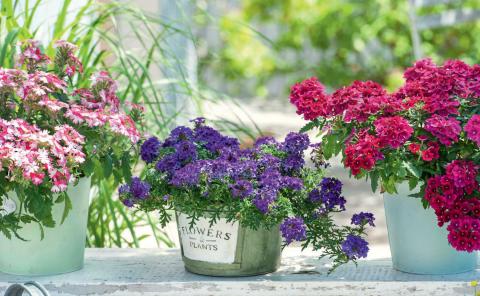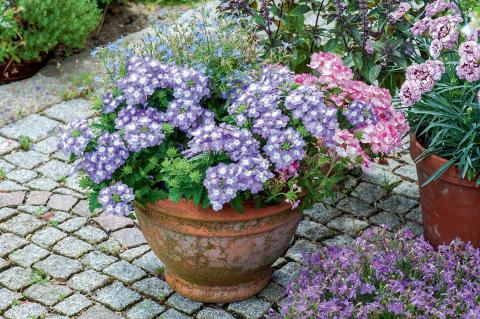Verbena, herb-of-the-cross
Full of flowers, easy to care for and undemanding: Verbena in pots and balcony containers require little care and are quite a delight. Here’s how to plant and care for them.
Factsheet
- Growth type
-
- one year old
- Growth height (from)
- from 15 cm to 30 cm
- Growth width (from)
- from 0 cm to 0 cm
- Growth characteristics
-
- overhanging
- Flower color
-
- purple
- green
- yellow
- orange
- red
- pink
- white
- brown
- multicolored
- Flowering time (month)
-
- May to October
- Flower shape
-
- umbels
- Leaf color
-
- green
- page format
-
- lobbed
- oblong
- Sheet properties
-
- evergreen
- Light
-
- sunny to semi-shade
- Soil type
-
- sandy to loamy
- Soil Moisture
-
- fresh
- ph value
-
- neutral
- Lime compatibility
-
- lime-tolerant
- Nutrient requirements
-
- nutrient-rich
- Decorative or utility value
-
- Flower Decoration
- Nectar or pollen plant
- Use
-
- Flowerbeds
- ground cover
- Group planting
- Planters
- Garden style
-
- Flower garden
- Pot garden
- Bee Friendly
- bee friendly plant
Verbenas belong to the family of herb-of-the-cross (Verbenaceae), which is why they are simply sold as "verbena". The genus, originally from South America, includes several species and is spread all over the world. Even in olden times, the wild species native to Europe, verbena officinalis, was considered the plant of birth miracles and a remedy for injuries. Verbena also has various miraculous and protective properties in popular mythology. The verbenas available today for box and container gardening are all hybrids with a long history of cultivation and breeding. Patagonian verbena (Verbena bonariensis) is also very popular as a short-lived garden shrub. t seeds itself in suitable locations.
Verbenas are annual herbaceous plants, some varieties of which grow upright and others grow as creepers. The stems are peculiarly square. Depending on the species, verbenas grow to different heights, the classic pot hybrids reach between 5.91 and 11.81 inches in height. Its delicate structure gives the verbena a graceful elegance. The plants give off a slightly spicy fragrance and attract many butterflies..

The single, sometimes coarse-haired leaves of the verbena have a jagged edge. Their lobed or pinnate appearance provides a dense but breezy background for the colorful flower umbrellas.
The verbena has lush flowers of all colors except yellow. The multi-flowered inflorescences appear in attractive umbrella-shaped or spherical umbels. The striped or star blossoms from the “Voodoo Star” series as well as two- and multi-colored varieties of the ‘Lanai Twister’ varieties and “Wicked” series are extremely decorative. The flowering period of the verbena lasts from May to the first frost.
Verbenas are not particularly demanding when it comes to their planting location. It should be sunny and warm, and even summer heat is well tolerated. Newer cultivars are extremely stable, even wind and rain do not disturb the gently undulating flowers. The substrate should be slightly acidic, rich in humus, slightly moist and well-drained. Good potting soil and a south-facing location are ideal for planting in a container or balcony box.

Planting verbena is not magic. The summer bloomers can be planted almost any time during the season. Since verbena is extremely sensitive to frost, you should plant it after the last frost. Maintain the planting distances indicated on the plant pot (between 9.84 and 19.68 inches). The planting hole in the flower bed should be filled with a little compost. A layer of mulch reduces the water requirement. It is best to place verbenas in small tuffs for summer planting in the flower bed, so they quickly form a dense carpet of flowers. A drainage layer made of expanded clay is recommended when planting in pots or balcony boxes. When planted in fresh potting soil, the balcony stars usually bloom in a sunny spot continuously until frost.
The verbena is an undemanding, continuously flowering plant and therefore well suited for novice gardeners and balcony gardeners. For verbena to thrive, all you need is to water it and fertilize it regularly. On a hot summer day that could mean up to 1.5 liters of water per plant. The soil in the container must neither dry out nor become waterlogged. You should therefore always pour off any standing water in the coaster immediately. You encourage the regrowth of new flower balls by constantly removing the wilted ones. Regular weekly fertilization with a liquid flowering plant fertilizer promotes the development of new flower buds.

As verbenas aren’t typically winter-hardy, overwintering is not worthwhile. In addition, perennial plants are often not very attractive and fail to bloom. However, if you have pruned the plants in late summer, it is best to leave them in a bright, cool place in the house during the winter months until they are large and strong enough to be planted in May.
Verbenas look good both alone and in combination with other balcony classics such as petunias, vanilla blossoms, begonias or million bells. You can choose a verbena that works best for you, from a wide variety of verbenas. This mainly depends on whether you choose compact growing varieties or those with long, hanging shoots that need more space to grow. Flat and compact growing verbenas with fine foliage and small to medium-sized umbels are well suited for small containers (for example the breeding varieties “Lindolena”, “Vectura” or “Vepita”). Variants with strong, hanging shoots also sparkle in hanging baskets or as understory plant below tall trunks (for example the “Samira” or “Empress” series). In the flower bed, standing verbenas are wonderful as understory plants with or hibiscus. And if you can't decide between the multitude of colors: In the "Trio" mixtures, gardeners have combined three selected varieties with uniform growth and the same flowering behavior in one pot to create a magnificent play of colors. This guarantees cheerful eye-catchers on the balcony or in the flower bed.
The variety “Lila Luzi” from the “Wicked” series by Dümmen Orange was chosen by the Horticultural Association of Baden-Württemberg-Hessen as "Flower bed and Balcony Flower 2017". It impresses with a compact, semi-upright growth and attractive two-tone flowers that are bright blue on the outside and have a white, star-shaped center. “Bright Rose” is a continuously blooming, bright pink-colored classic that needs a covered location. The “Lanai” and “Tapien” series, with their overhanging growth, are suitable for planting in hanging baskets and balcony boxes.

If you don’t wish to buy balcony verbena varieties every year, you can propagate healthy plants using cuttings. For this purpose, shoot tips about 3.93 inches long are cut off from the parent plant in late summer or autumn, dipped in rooting powder and put in potting soil. Remove the lower pairs of leaves, moisten the substrate and cover the propagation box with cling film. For the cuttings to develop roots, place the cuttings in as warm and bright place as possible. Once strong roots have formed, the young plant is transferred to a plant pot and kept in the house during the winter months. From May onwards, you can gradually acclimatize it to the outdoor conditions. In the flower bed the annual verbena propagates by self-sowing. If you prefer to sow in a systematic manner, collect the seed pods in autumn. In February, the seeds can be grown in seed trays on the windowsill. To do this, just press the verbena seeds lightly into the substrate, moisten the soil and place the seed tray in a very bright place at around 68 degrees Fahrenheit room temperature. After a few weeks, the offspring are large enough to be pricked out. The plants can be kept outdoors only after the last frost. From May onwards, sowing can also be done directly in the open air, but the flowers will appear much later than in specimens sown earlier.

Verbenas have to deal with the same pests as most other balcony flowers, which include aphids, spider mites and white flies. In the wild they are popular snail food. If leaves turn yellow, adding an iron fertilizer will help. Earlier, the verbenas used to be particularly prone to powdery mildew, however, most of the newer breeds are now resistant.
Frequently Asked Questions
What is a herb-of-the-cross?
Herb-of-the-cross or verbena is a genus of plants from the verbena family (Verbenaceae), which includes over 250 species. Verbena hybrids are mainly available as balcony flowers. Well-known species are the verbena (Verbena officinalis), a native wild species, and the Patagonian verbena(Verbena bonariensis), a popular garden shrub.
What does a herb-of-a-cross look like?
Depending on the variety, verbena hybrids are available as upright plants or creepers. The popular pot hybrids grow up to a height of around 11.81 inches. Verbenas have a square stem, single leaves that are sometimes rough-haired, lobed or pinnate, and lush flowers that light up in all colors - except yellow.
Where do verbenas grow?
Verbena originally comes from South America, but can now be found almost anywhere around the world. In Germany, verbenas prefer to grow in a warm and sunny location in a well-drained, slightly acidic and humus-rich substrate that’s always moist.
Is verbena winter-hardy?
As verbenas or herb-of-the-cross originally come from a very warm climate, they are unfortunately not winter-hardy.


